Impact of Protein Energy Malnutrition on Global Scale
VerifiedAdded on 2023/06/14
|12
|3492
|492
AI Summary
This essay discusses the impact of protein energy malnutrition on a global scale, including determinants of key international nutritional issues, analysis of public health nutrition issues, and recent interventions. It also explores similarities and differences in protein-energy malnutrition by developing and economically developed countries, and issues in public health nutrition at a global level.
Contribute Materials
Your contribution can guide someone’s learning journey. Share your
documents today.
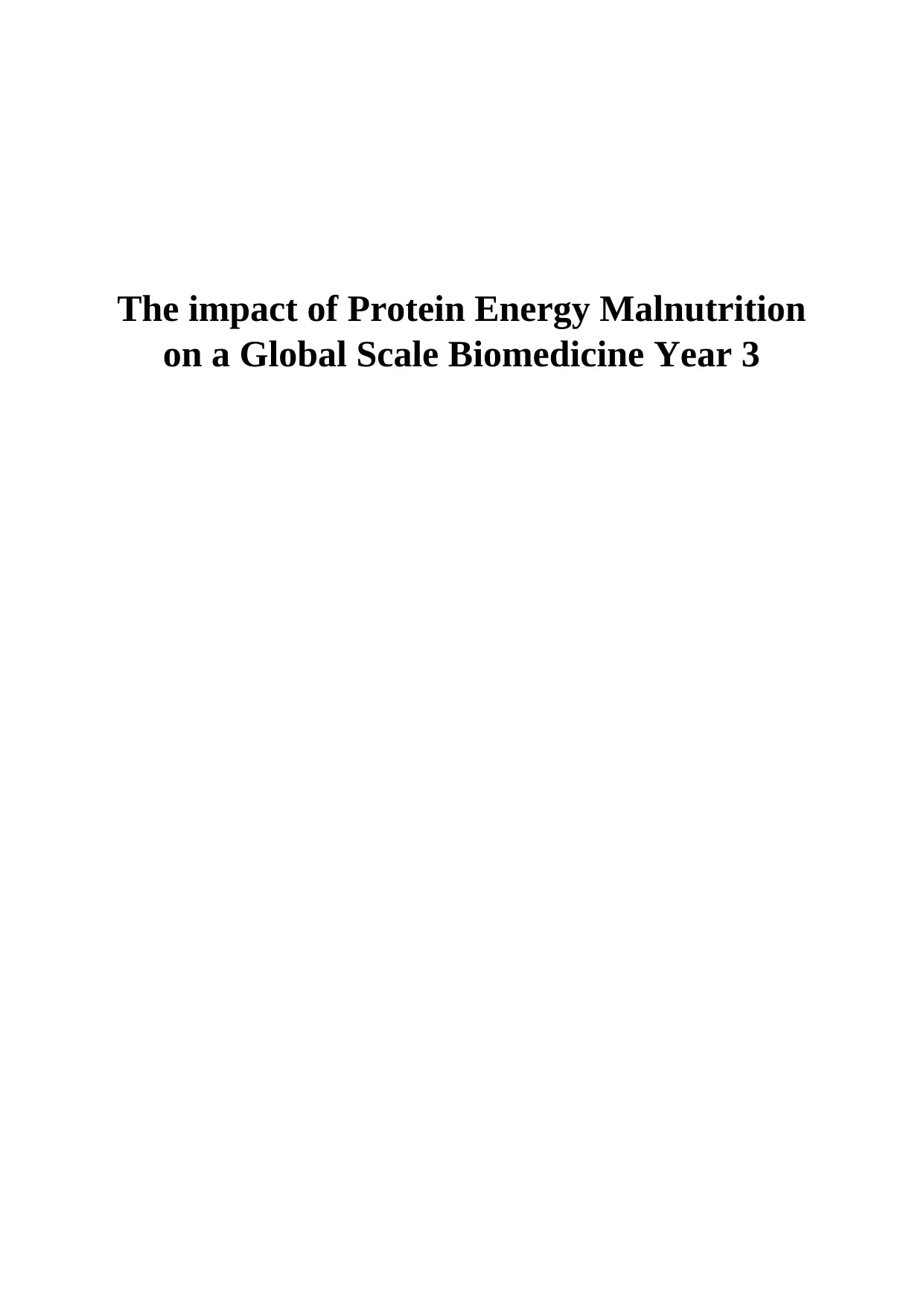
The impact of Protein Energy Malnutrition
on a Global Scale Biomedicine Year 3
on a Global Scale Biomedicine Year 3
Secure Best Marks with AI Grader
Need help grading? Try our AI Grader for instant feedback on your assignments.
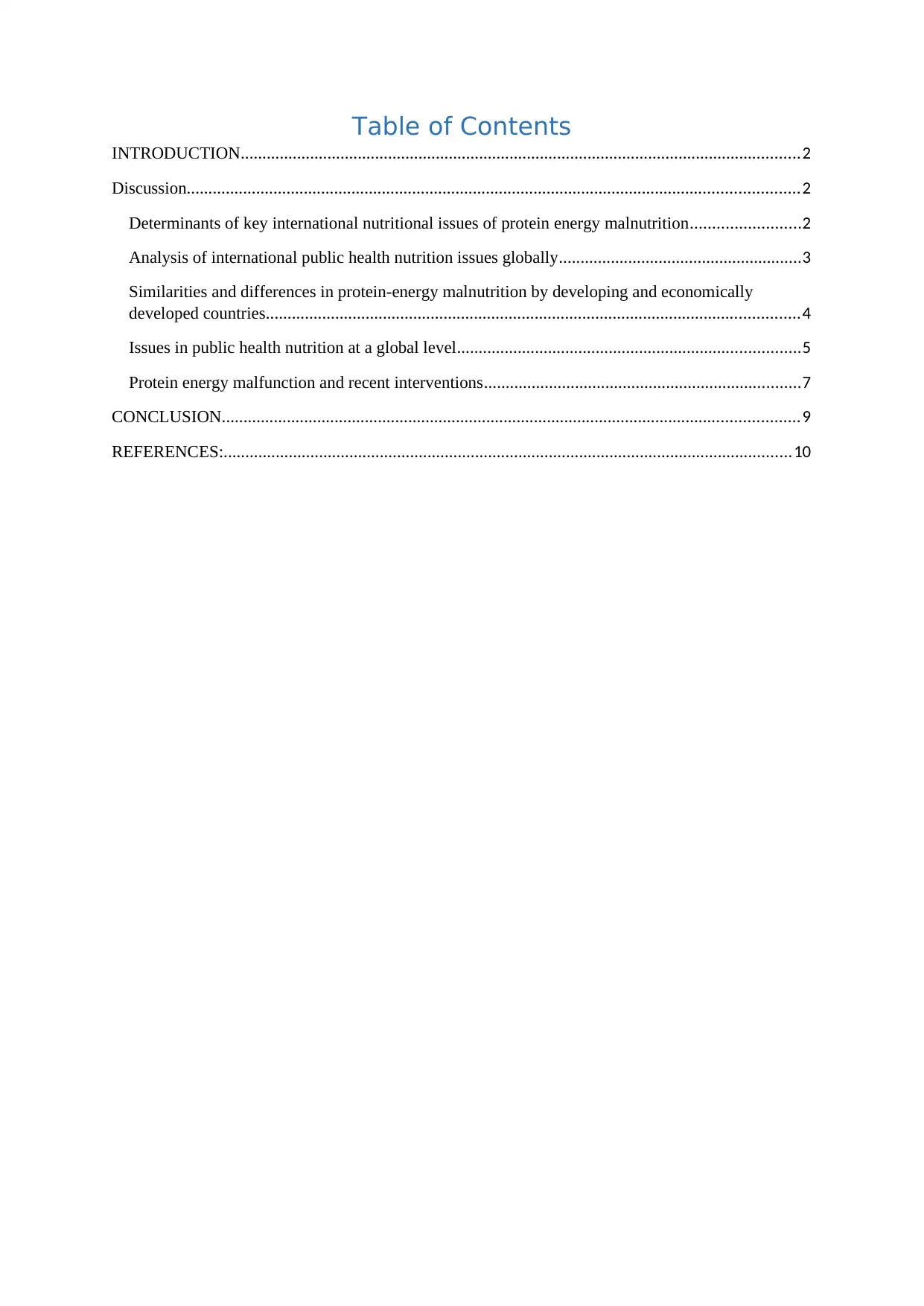
Table of Contents
INTRODUCTION.................................................................................................................................2
Discussion.............................................................................................................................................2
Determinants of key international nutritional issues of protein energy malnutrition.........................2
Analysis of international public health nutrition issues globally........................................................3
Similarities and differences in protein-energy malnutrition by developing and economically
developed countries...........................................................................................................................4
Issues in public health nutrition at a global level...............................................................................5
Protein energy malfunction and recent interventions.........................................................................7
CONCLUSION.....................................................................................................................................9
REFERENCES:...................................................................................................................................10
INTRODUCTION.................................................................................................................................2
Discussion.............................................................................................................................................2
Determinants of key international nutritional issues of protein energy malnutrition.........................2
Analysis of international public health nutrition issues globally........................................................3
Similarities and differences in protein-energy malnutrition by developing and economically
developed countries...........................................................................................................................4
Issues in public health nutrition at a global level...............................................................................5
Protein energy malfunction and recent interventions.........................................................................7
CONCLUSION.....................................................................................................................................9
REFERENCES:...................................................................................................................................10
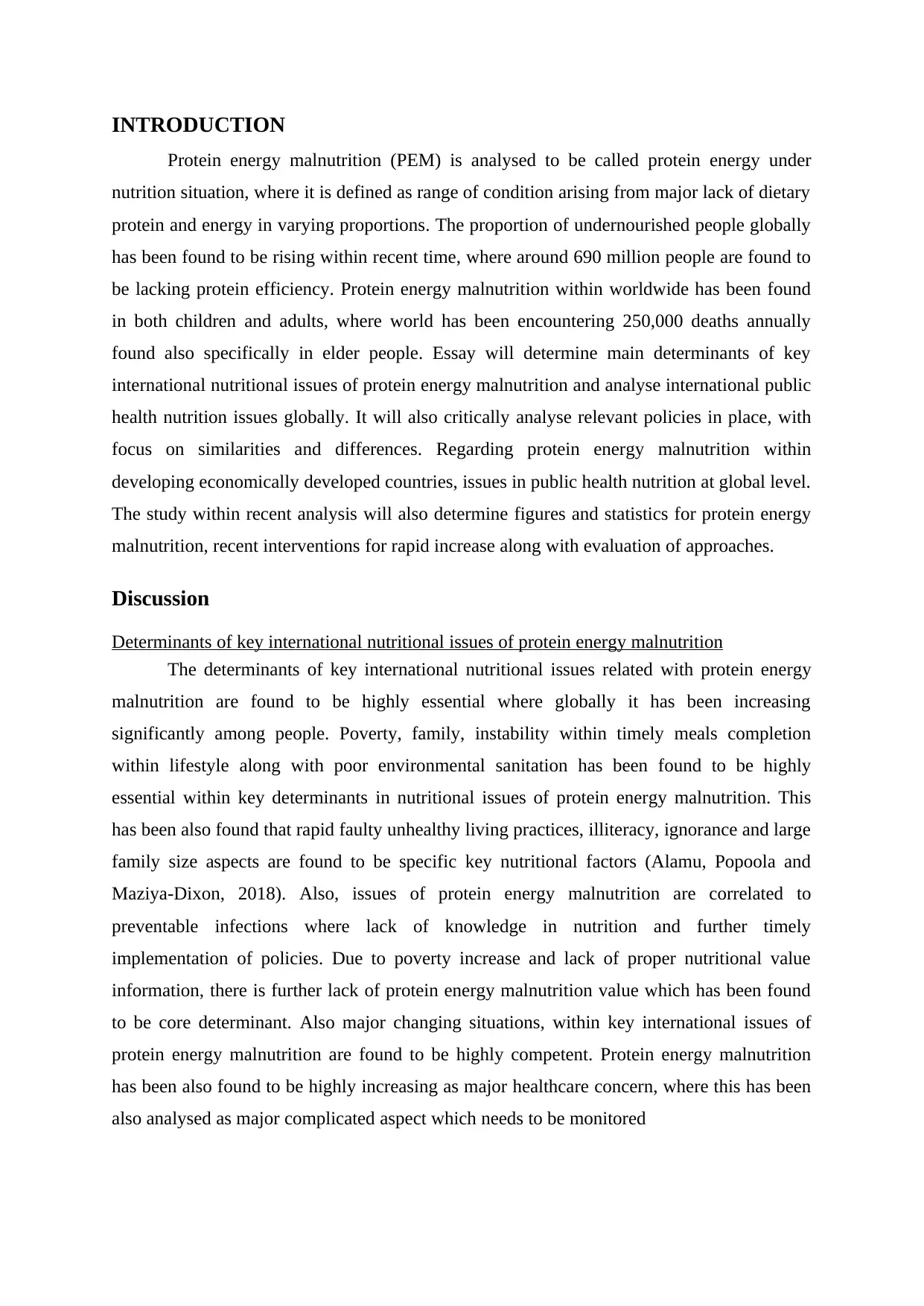
INTRODUCTION
Protein energy malnutrition (PEM) is analysed to be called protein energy under
nutrition situation, where it is defined as range of condition arising from major lack of dietary
protein and energy in varying proportions. The proportion of undernourished people globally
has been found to be rising within recent time, where around 690 million people are found to
be lacking protein efficiency. Protein energy malnutrition within worldwide has been found
in both children and adults, where world has been encountering 250,000 deaths annually
found also specifically in elder people. Essay will determine main determinants of key
international nutritional issues of protein energy malnutrition and analyse international public
health nutrition issues globally. It will also critically analyse relevant policies in place, with
focus on similarities and differences. Regarding protein energy malnutrition within
developing economically developed countries, issues in public health nutrition at global level.
The study within recent analysis will also determine figures and statistics for protein energy
malnutrition, recent interventions for rapid increase along with evaluation of approaches.
Discussion
Determinants of key international nutritional issues of protein energy malnutrition
The determinants of key international nutritional issues related with protein energy
malnutrition are found to be highly essential where globally it has been increasing
significantly among people. Poverty, family, instability within timely meals completion
within lifestyle along with poor environmental sanitation has been found to be highly
essential within key determinants in nutritional issues of protein energy malnutrition. This
has been also found that rapid faulty unhealthy living practices, illiteracy, ignorance and large
family size aspects are found to be specific key nutritional factors (Alamu, Popoola and
Maziya‐Dixon, 2018). Also, issues of protein energy malnutrition are correlated to
preventable infections where lack of knowledge in nutrition and further timely
implementation of policies. Due to poverty increase and lack of proper nutritional value
information, there is further lack of protein energy malnutrition value which has been found
to be core determinant. Also major changing situations, within key international issues of
protein energy malnutrition are found to be highly competent. Protein energy malnutrition
has been also found to be highly increasing as major healthcare concern, where this has been
also analysed as major complicated aspect which needs to be monitored
Protein energy malnutrition (PEM) is analysed to be called protein energy under
nutrition situation, where it is defined as range of condition arising from major lack of dietary
protein and energy in varying proportions. The proportion of undernourished people globally
has been found to be rising within recent time, where around 690 million people are found to
be lacking protein efficiency. Protein energy malnutrition within worldwide has been found
in both children and adults, where world has been encountering 250,000 deaths annually
found also specifically in elder people. Essay will determine main determinants of key
international nutritional issues of protein energy malnutrition and analyse international public
health nutrition issues globally. It will also critically analyse relevant policies in place, with
focus on similarities and differences. Regarding protein energy malnutrition within
developing economically developed countries, issues in public health nutrition at global level.
The study within recent analysis will also determine figures and statistics for protein energy
malnutrition, recent interventions for rapid increase along with evaluation of approaches.
Discussion
Determinants of key international nutritional issues of protein energy malnutrition
The determinants of key international nutritional issues related with protein energy
malnutrition are found to be highly essential where globally it has been increasing
significantly among people. Poverty, family, instability within timely meals completion
within lifestyle along with poor environmental sanitation has been found to be highly
essential within key determinants in nutritional issues of protein energy malnutrition. This
has been also found that rapid faulty unhealthy living practices, illiteracy, ignorance and large
family size aspects are found to be specific key nutritional factors (Alamu, Popoola and
Maziya‐Dixon, 2018). Also, issues of protein energy malnutrition are correlated to
preventable infections where lack of knowledge in nutrition and further timely
implementation of policies. Due to poverty increase and lack of proper nutritional value
information, there is further lack of protein energy malnutrition value which has been found
to be core determinant. Also major changing situations, within key international issues of
protein energy malnutrition are found to be highly competent. Protein energy malnutrition
has been also found to be highly increasing as major healthcare concern, where this has been
also analysed as major complicated aspect which needs to be monitored
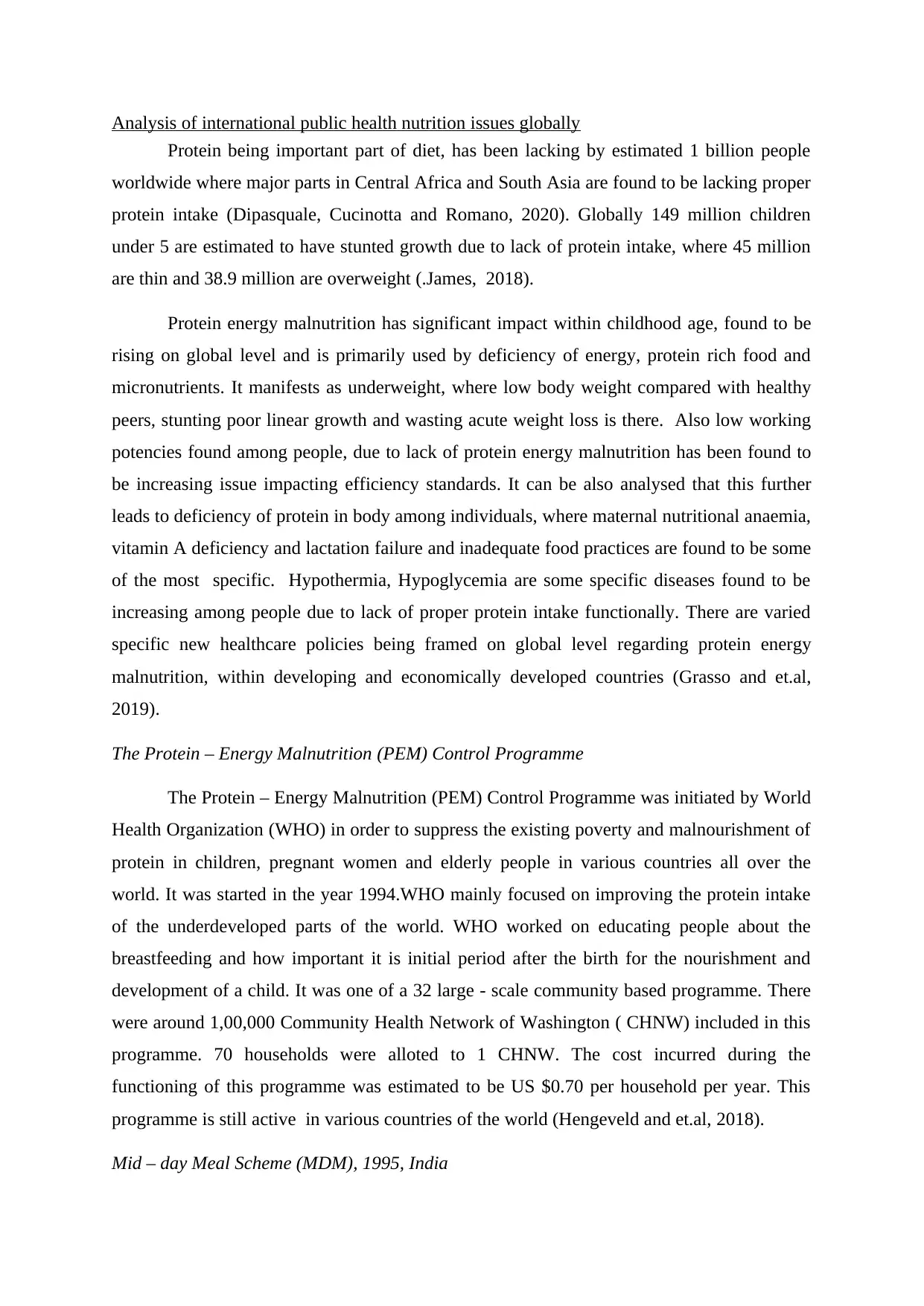
Analysis of international public health nutrition issues globally
Protein being important part of diet, has been lacking by estimated 1 billion people
worldwide where major parts in Central Africa and South Asia are found to be lacking proper
protein intake (Dipasquale, Cucinotta and Romano, 2020). Globally 149 million children
under 5 are estimated to have stunted growth due to lack of protein intake, where 45 million
are thin and 38.9 million are overweight (.James, 2018).
Protein energy malnutrition has significant impact within childhood age, found to be
rising on global level and is primarily used by deficiency of energy, protein rich food and
micronutrients. It manifests as underweight, where low body weight compared with healthy
peers, stunting poor linear growth and wasting acute weight loss is there. Also low working
potencies found among people, due to lack of protein energy malnutrition has been found to
be increasing issue impacting efficiency standards. It can be also analysed that this further
leads to deficiency of protein in body among individuals, where maternal nutritional anaemia,
vitamin A deficiency and lactation failure and inadequate food practices are found to be some
of the most specific. Hypothermia, Hypoglycemia are some specific diseases found to be
increasing among people due to lack of proper protein intake functionally. There are varied
specific new healthcare policies being framed on global level regarding protein energy
malnutrition, within developing and economically developed countries (Grasso and et.al,
2019).
The Protein – Energy Malnutrition (PEM) Control Programme
The Protein – Energy Malnutrition (PEM) Control Programme was initiated by World
Health Organization (WHO) in order to suppress the existing poverty and malnourishment of
protein in children, pregnant women and elderly people in various countries all over the
world. It was started in the year 1994.WHO mainly focused on improving the protein intake
of the underdeveloped parts of the world. WHO worked on educating people about the
breastfeeding and how important it is initial period after the birth for the nourishment and
development of a child. It was one of a 32 large - scale community based programme. There
were around 1,00,000 Community Health Network of Washington ( CHNW) included in this
programme. 70 households were alloted to 1 CHNW. The cost incurred during the
functioning of this programme was estimated to be US $0.70 per household per year. This
programme is still active in various countries of the world (Hengeveld and et.al, 2018).
Mid – day Meal Scheme (MDM), 1995, India
Protein being important part of diet, has been lacking by estimated 1 billion people
worldwide where major parts in Central Africa and South Asia are found to be lacking proper
protein intake (Dipasquale, Cucinotta and Romano, 2020). Globally 149 million children
under 5 are estimated to have stunted growth due to lack of protein intake, where 45 million
are thin and 38.9 million are overweight (.James, 2018).
Protein energy malnutrition has significant impact within childhood age, found to be
rising on global level and is primarily used by deficiency of energy, protein rich food and
micronutrients. It manifests as underweight, where low body weight compared with healthy
peers, stunting poor linear growth and wasting acute weight loss is there. Also low working
potencies found among people, due to lack of protein energy malnutrition has been found to
be increasing issue impacting efficiency standards. It can be also analysed that this further
leads to deficiency of protein in body among individuals, where maternal nutritional anaemia,
vitamin A deficiency and lactation failure and inadequate food practices are found to be some
of the most specific. Hypothermia, Hypoglycemia are some specific diseases found to be
increasing among people due to lack of proper protein intake functionally. There are varied
specific new healthcare policies being framed on global level regarding protein energy
malnutrition, within developing and economically developed countries (Grasso and et.al,
2019).
The Protein – Energy Malnutrition (PEM) Control Programme
The Protein – Energy Malnutrition (PEM) Control Programme was initiated by World
Health Organization (WHO) in order to suppress the existing poverty and malnourishment of
protein in children, pregnant women and elderly people in various countries all over the
world. It was started in the year 1994.WHO mainly focused on improving the protein intake
of the underdeveloped parts of the world. WHO worked on educating people about the
breastfeeding and how important it is initial period after the birth for the nourishment and
development of a child. It was one of a 32 large - scale community based programme. There
were around 1,00,000 Community Health Network of Washington ( CHNW) included in this
programme. 70 households were alloted to 1 CHNW. The cost incurred during the
functioning of this programme was estimated to be US $0.70 per household per year. This
programme is still active in various countries of the world (Hengeveld and et.al, 2018).
Mid – day Meal Scheme (MDM), 1995, India
Secure Best Marks with AI Grader
Need help grading? Try our AI Grader for instant feedback on your assignments.
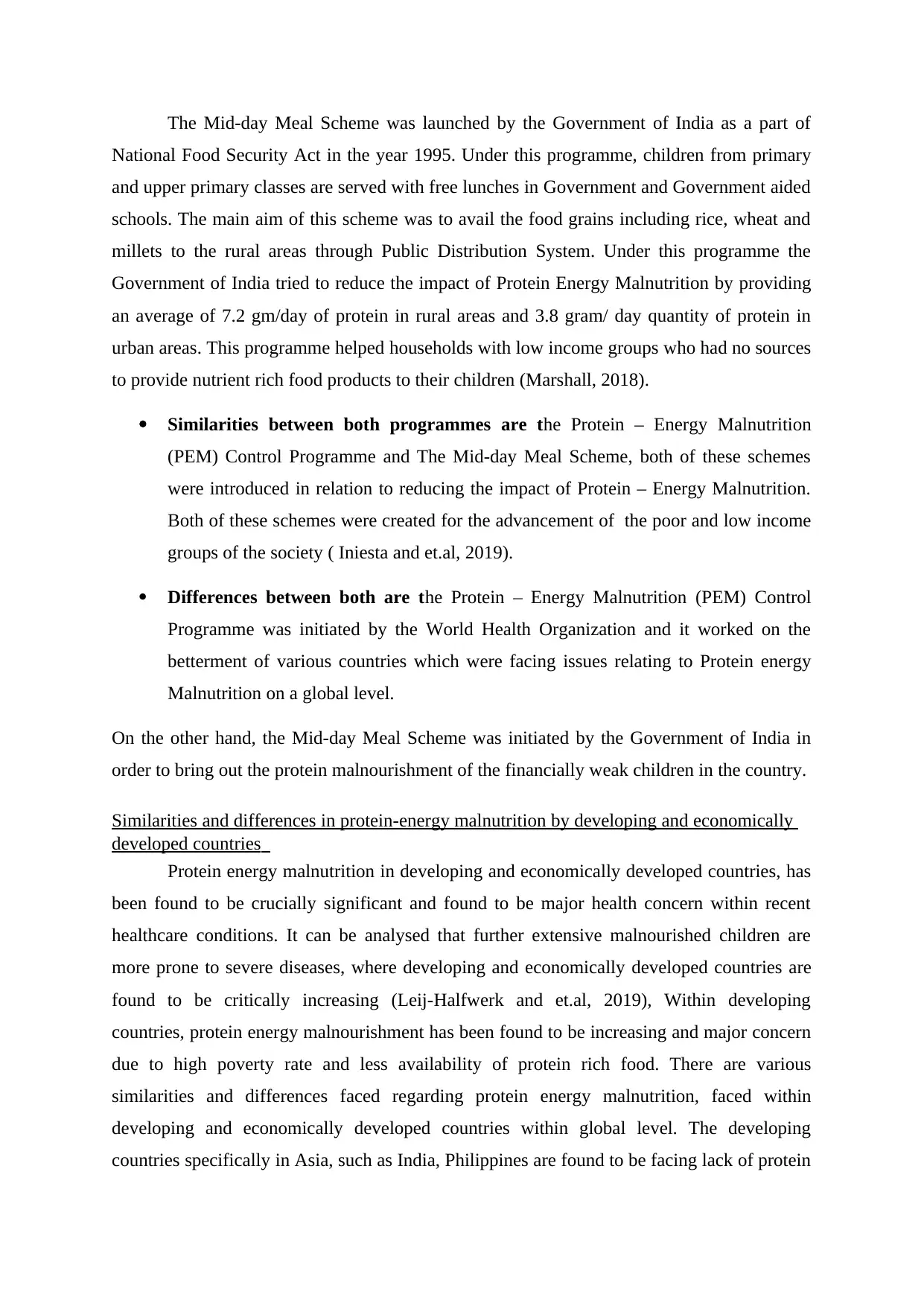
The Mid-day Meal Scheme was launched by the Government of India as a part of
National Food Security Act in the year 1995. Under this programme, children from primary
and upper primary classes are served with free lunches in Government and Government aided
schools. The main aim of this scheme was to avail the food grains including rice, wheat and
millets to the rural areas through Public Distribution System. Under this programme the
Government of India tried to reduce the impact of Protein Energy Malnutrition by providing
an average of 7.2 gm/day of protein in rural areas and 3.8 gram/ day quantity of protein in
urban areas. This programme helped households with low income groups who had no sources
to provide nutrient rich food products to their children (Marshall, 2018).
Similarities between both programmes are the Protein – Energy Malnutrition
(PEM) Control Programme and The Mid-day Meal Scheme, both of these schemes
were introduced in relation to reducing the impact of Protein – Energy Malnutrition.
Both of these schemes were created for the advancement of the poor and low income
groups of the society ( Iniesta and et.al, 2019).
Differences between both are the Protein – Energy Malnutrition (PEM) Control
Programme was initiated by the World Health Organization and it worked on the
betterment of various countries which were facing issues relating to Protein energy
Malnutrition on a global level.
On the other hand, the Mid-day Meal Scheme was initiated by the Government of India in
order to bring out the protein malnourishment of the financially weak children in the country.
Similarities and differences in protein-energy malnutrition by developing and economically
developed countries
Protein energy malnutrition in developing and economically developed countries, has
been found to be crucially significant and found to be major health concern within recent
healthcare conditions. It can be analysed that further extensive malnourished children are
more prone to severe diseases, where developing and economically developed countries are
found to be critically increasing (Leij-Halfwerk and et.al, 2019), Within developing
countries, protein energy malnourishment has been found to be increasing and major concern
due to high poverty rate and less availability of protein rich food. There are various
similarities and differences faced regarding protein energy malnutrition, faced within
developing and economically developed countries within global level. The developing
countries specifically in Asia, such as India, Philippines are found to be facing lack of protein
National Food Security Act in the year 1995. Under this programme, children from primary
and upper primary classes are served with free lunches in Government and Government aided
schools. The main aim of this scheme was to avail the food grains including rice, wheat and
millets to the rural areas through Public Distribution System. Under this programme the
Government of India tried to reduce the impact of Protein Energy Malnutrition by providing
an average of 7.2 gm/day of protein in rural areas and 3.8 gram/ day quantity of protein in
urban areas. This programme helped households with low income groups who had no sources
to provide nutrient rich food products to their children (Marshall, 2018).
Similarities between both programmes are the Protein – Energy Malnutrition
(PEM) Control Programme and The Mid-day Meal Scheme, both of these schemes
were introduced in relation to reducing the impact of Protein – Energy Malnutrition.
Both of these schemes were created for the advancement of the poor and low income
groups of the society ( Iniesta and et.al, 2019).
Differences between both are the Protein – Energy Malnutrition (PEM) Control
Programme was initiated by the World Health Organization and it worked on the
betterment of various countries which were facing issues relating to Protein energy
Malnutrition on a global level.
On the other hand, the Mid-day Meal Scheme was initiated by the Government of India in
order to bring out the protein malnourishment of the financially weak children in the country.
Similarities and differences in protein-energy malnutrition by developing and economically
developed countries
Protein energy malnutrition in developing and economically developed countries, has
been found to be crucially significant and found to be major health concern within recent
healthcare conditions. It can be analysed that further extensive malnourished children are
more prone to severe diseases, where developing and economically developed countries are
found to be critically increasing (Leij-Halfwerk and et.al, 2019), Within developing
countries, protein energy malnourishment has been found to be increasing and major concern
due to high poverty rate and less availability of protein rich food. There are various
similarities and differences faced regarding protein energy malnutrition, faced within
developing and economically developed countries within global level. The developing
countries specifically in Asia, such as India, Philippines are found to be facing lack of protein
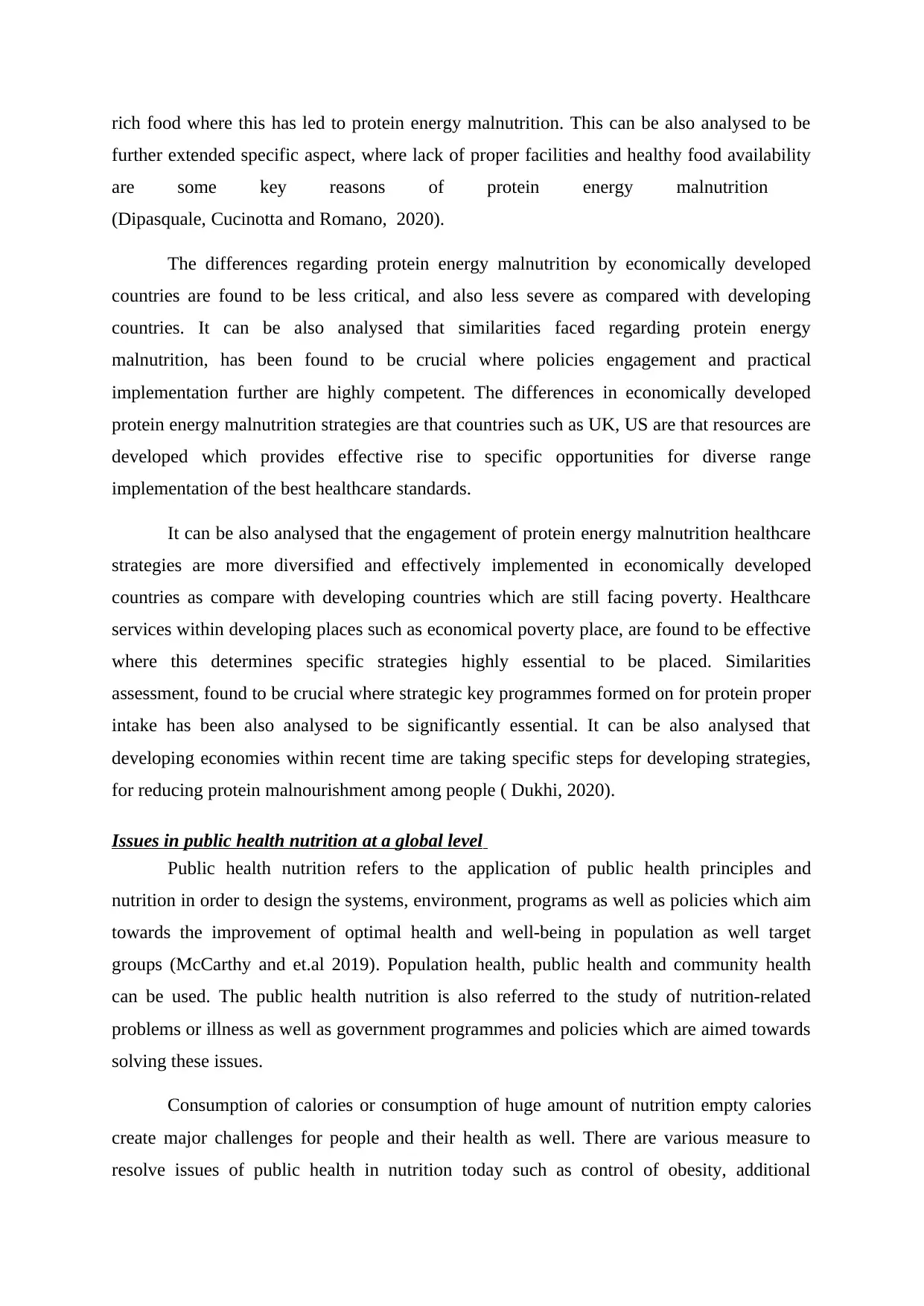
rich food where this has led to protein energy malnutrition. This can be also analysed to be
further extended specific aspect, where lack of proper facilities and healthy food availability
are some key reasons of protein energy malnutrition
(Dipasquale, Cucinotta and Romano, 2020).
The differences regarding protein energy malnutrition by economically developed
countries are found to be less critical, and also less severe as compared with developing
countries. It can be also analysed that similarities faced regarding protein energy
malnutrition, has been found to be crucial where policies engagement and practical
implementation further are highly competent. The differences in economically developed
protein energy malnutrition strategies are that countries such as UK, US are that resources are
developed which provides effective rise to specific opportunities for diverse range
implementation of the best healthcare standards.
It can be also analysed that the engagement of protein energy malnutrition healthcare
strategies are more diversified and effectively implemented in economically developed
countries as compare with developing countries which are still facing poverty. Healthcare
services within developing places such as economical poverty place, are found to be effective
where this determines specific strategies highly essential to be placed. Similarities
assessment, found to be crucial where strategic key programmes formed on for protein proper
intake has been also analysed to be significantly essential. It can be also analysed that
developing economies within recent time are taking specific steps for developing strategies,
for reducing protein malnourishment among people ( Dukhi, 2020).
Issues in public health nutrition at a global level
Public health nutrition refers to the application of public health principles and
nutrition in order to design the systems, environment, programs as well as policies which aim
towards the improvement of optimal health and well-being in population as well target
groups (McCarthy and et.al 2019). Population health, public health and community health
can be used. The public health nutrition is also referred to the study of nutrition-related
problems or illness as well as government programmes and policies which are aimed towards
solving these issues.
Consumption of calories or consumption of huge amount of nutrition empty calories
create major challenges for people and their health as well. There are various measure to
resolve issues of public health in nutrition today such as control of obesity, additional
further extended specific aspect, where lack of proper facilities and healthy food availability
are some key reasons of protein energy malnutrition
(Dipasquale, Cucinotta and Romano, 2020).
The differences regarding protein energy malnutrition by economically developed
countries are found to be less critical, and also less severe as compared with developing
countries. It can be also analysed that similarities faced regarding protein energy
malnutrition, has been found to be crucial where policies engagement and practical
implementation further are highly competent. The differences in economically developed
protein energy malnutrition strategies are that countries such as UK, US are that resources are
developed which provides effective rise to specific opportunities for diverse range
implementation of the best healthcare standards.
It can be also analysed that the engagement of protein energy malnutrition healthcare
strategies are more diversified and effectively implemented in economically developed
countries as compare with developing countries which are still facing poverty. Healthcare
services within developing places such as economical poverty place, are found to be effective
where this determines specific strategies highly essential to be placed. Similarities
assessment, found to be crucial where strategic key programmes formed on for protein proper
intake has been also analysed to be significantly essential. It can be also analysed that
developing economies within recent time are taking specific steps for developing strategies,
for reducing protein malnourishment among people ( Dukhi, 2020).
Issues in public health nutrition at a global level
Public health nutrition refers to the application of public health principles and
nutrition in order to design the systems, environment, programs as well as policies which aim
towards the improvement of optimal health and well-being in population as well target
groups (McCarthy and et.al 2019). Population health, public health and community health
can be used. The public health nutrition is also referred to the study of nutrition-related
problems or illness as well as government programmes and policies which are aimed towards
solving these issues.
Consumption of calories or consumption of huge amount of nutrition empty calories
create major challenges for people and their health as well. There are various measure to
resolve issues of public health in nutrition today such as control of obesity, additional
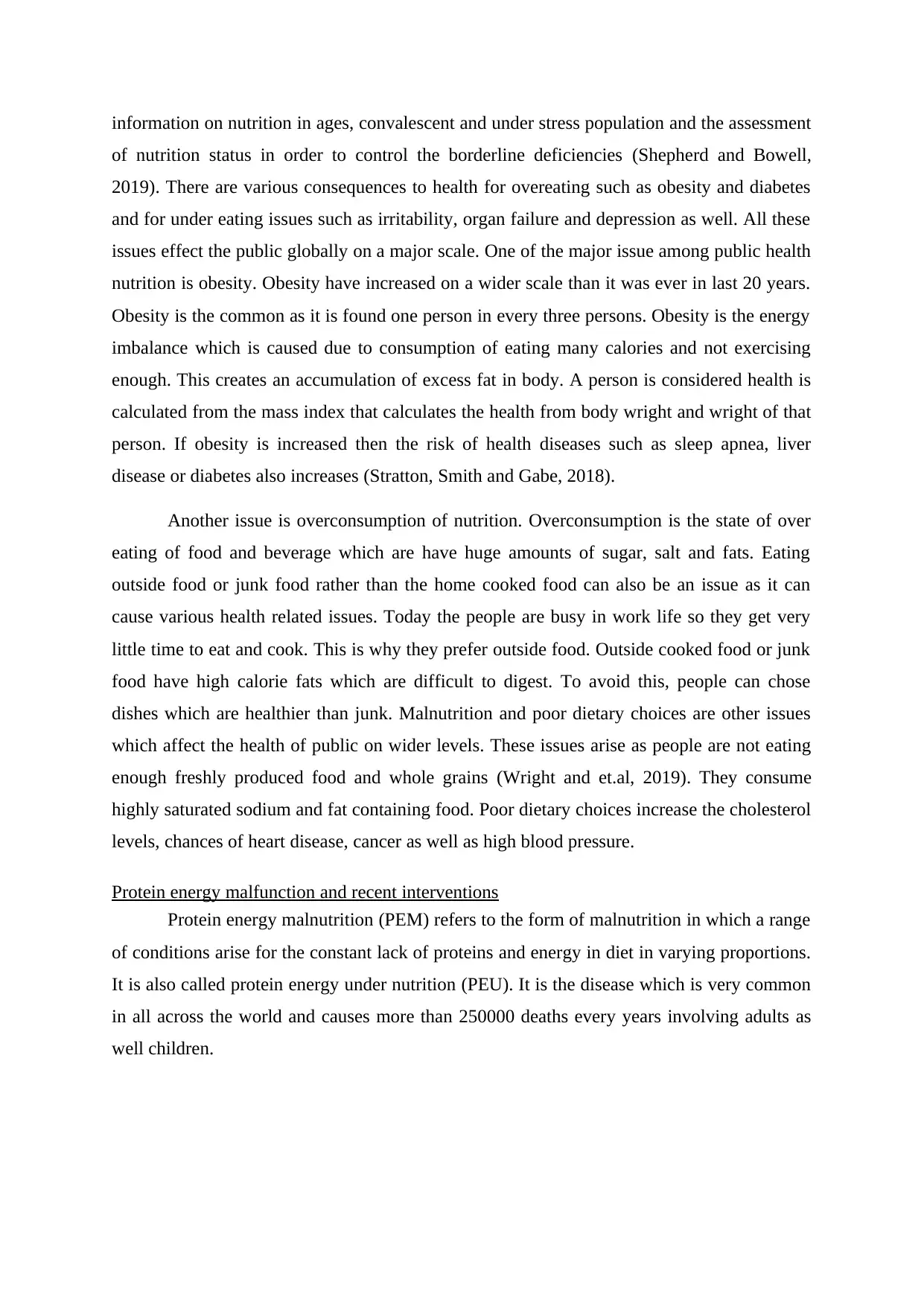
information on nutrition in ages, convalescent and under stress population and the assessment
of nutrition status in order to control the borderline deficiencies (Shepherd and Bowell,
2019). There are various consequences to health for overeating such as obesity and diabetes
and for under eating issues such as irritability, organ failure and depression as well. All these
issues effect the public globally on a major scale. One of the major issue among public health
nutrition is obesity. Obesity have increased on a wider scale than it was ever in last 20 years.
Obesity is the common as it is found one person in every three persons. Obesity is the energy
imbalance which is caused due to consumption of eating many calories and not exercising
enough. This creates an accumulation of excess fat in body. A person is considered health is
calculated from the mass index that calculates the health from body wright and wright of that
person. If obesity is increased then the risk of health diseases such as sleep apnea, liver
disease or diabetes also increases (Stratton, Smith and Gabe, 2018).
Another issue is overconsumption of nutrition. Overconsumption is the state of over
eating of food and beverage which are have huge amounts of sugar, salt and fats. Eating
outside food or junk food rather than the home cooked food can also be an issue as it can
cause various health related issues. Today the people are busy in work life so they get very
little time to eat and cook. This is why they prefer outside food. Outside cooked food or junk
food have high calorie fats which are difficult to digest. To avoid this, people can chose
dishes which are healthier than junk. Malnutrition and poor dietary choices are other issues
which affect the health of public on wider levels. These issues arise as people are not eating
enough freshly produced food and whole grains (Wright and et.al, 2019). They consume
highly saturated sodium and fat containing food. Poor dietary choices increase the cholesterol
levels, chances of heart disease, cancer as well as high blood pressure.
Protein energy malfunction and recent interventions
Protein energy malnutrition (PEM) refers to the form of malnutrition in which a range
of conditions arise for the constant lack of proteins and energy in diet in varying proportions.
It is also called protein energy under nutrition (PEU). It is the disease which is very common
in all across the world and causes more than 250000 deaths every years involving adults as
well children.
of nutrition status in order to control the borderline deficiencies (Shepherd and Bowell,
2019). There are various consequences to health for overeating such as obesity and diabetes
and for under eating issues such as irritability, organ failure and depression as well. All these
issues effect the public globally on a major scale. One of the major issue among public health
nutrition is obesity. Obesity have increased on a wider scale than it was ever in last 20 years.
Obesity is the common as it is found one person in every three persons. Obesity is the energy
imbalance which is caused due to consumption of eating many calories and not exercising
enough. This creates an accumulation of excess fat in body. A person is considered health is
calculated from the mass index that calculates the health from body wright and wright of that
person. If obesity is increased then the risk of health diseases such as sleep apnea, liver
disease or diabetes also increases (Stratton, Smith and Gabe, 2018).
Another issue is overconsumption of nutrition. Overconsumption is the state of over
eating of food and beverage which are have huge amounts of sugar, salt and fats. Eating
outside food or junk food rather than the home cooked food can also be an issue as it can
cause various health related issues. Today the people are busy in work life so they get very
little time to eat and cook. This is why they prefer outside food. Outside cooked food or junk
food have high calorie fats which are difficult to digest. To avoid this, people can chose
dishes which are healthier than junk. Malnutrition and poor dietary choices are other issues
which affect the health of public on wider levels. These issues arise as people are not eating
enough freshly produced food and whole grains (Wright and et.al, 2019). They consume
highly saturated sodium and fat containing food. Poor dietary choices increase the cholesterol
levels, chances of heart disease, cancer as well as high blood pressure.
Protein energy malfunction and recent interventions
Protein energy malnutrition (PEM) refers to the form of malnutrition in which a range
of conditions arise for the constant lack of proteins and energy in diet in varying proportions.
It is also called protein energy under nutrition (PEU). It is the disease which is very common
in all across the world and causes more than 250000 deaths every years involving adults as
well children.
Paraphrase This Document
Need a fresh take? Get an instant paraphrase of this document with our AI Paraphraser
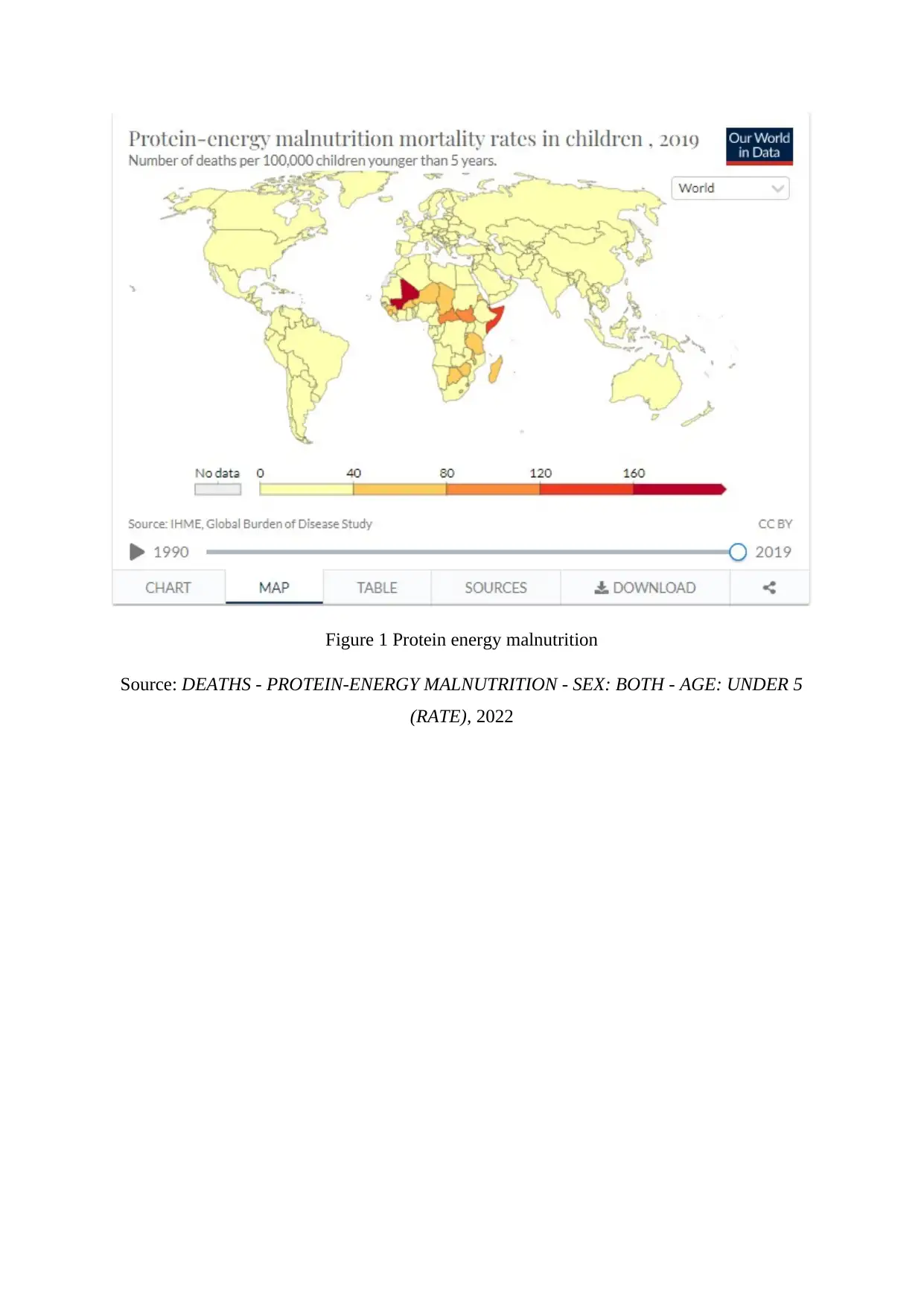
Figure 1 Protein energy malnutrition
Source: DEATHS - PROTEIN-ENERGY MALNUTRITION - SEX: BOTH - AGE: UNDER 5
(RATE), 2022
Source: DEATHS - PROTEIN-ENERGY MALNUTRITION - SEX: BOTH - AGE: UNDER 5
(RATE), 2022
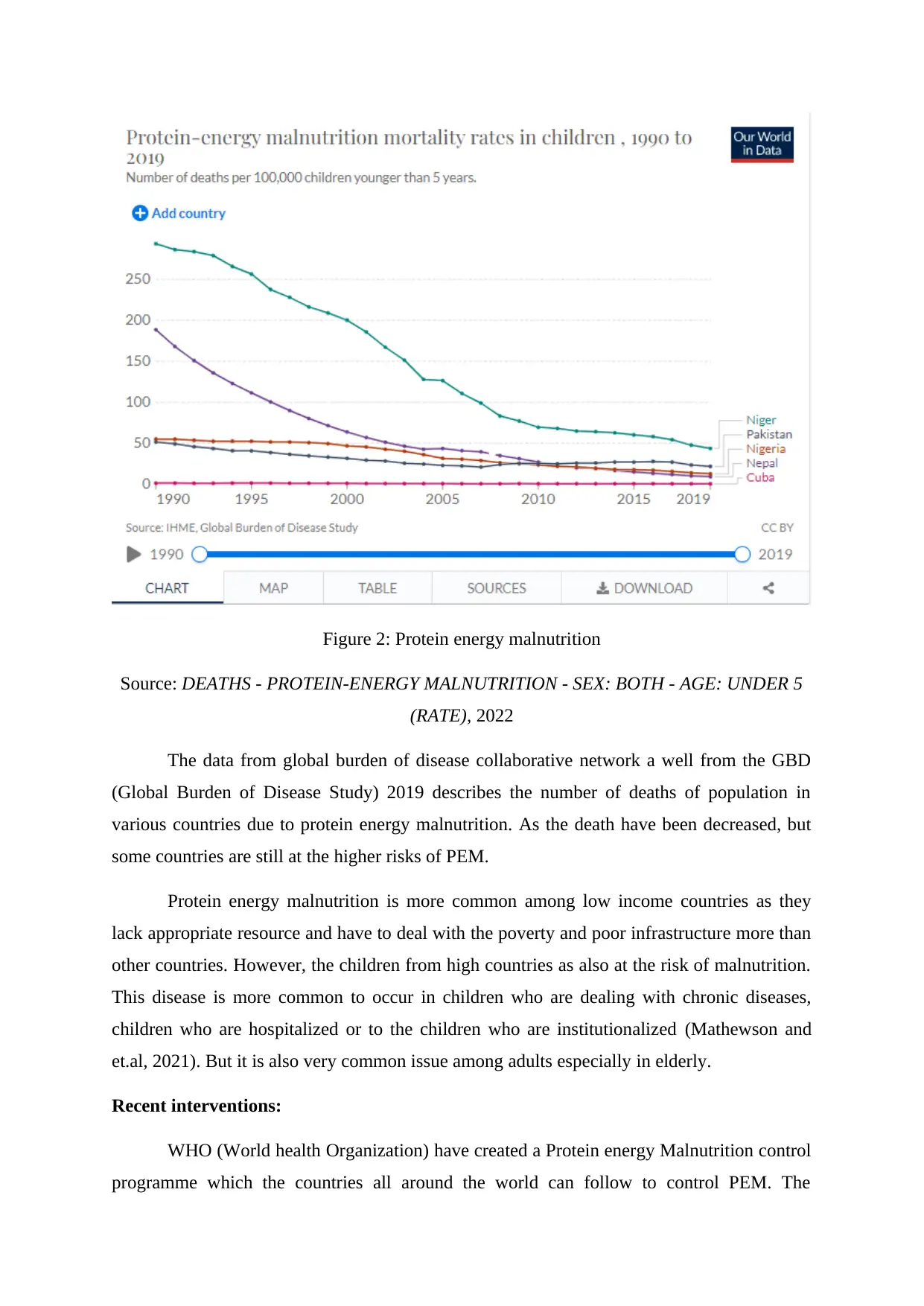
Figure 2: Protein energy malnutrition
Source: DEATHS - PROTEIN-ENERGY MALNUTRITION - SEX: BOTH - AGE: UNDER 5
(RATE), 2022
The data from global burden of disease collaborative network a well from the GBD
(Global Burden of Disease Study) 2019 describes the number of deaths of population in
various countries due to protein energy malnutrition. As the death have been decreased, but
some countries are still at the higher risks of PEM.
Protein energy malnutrition is more common among low income countries as they
lack appropriate resource and have to deal with the poverty and poor infrastructure more than
other countries. However, the children from high countries as also at the risk of malnutrition.
This disease is more common to occur in children who are dealing with chronic diseases,
children who are hospitalized or to the children who are institutionalized (Mathewson and
et.al, 2021). But it is also very common issue among adults especially in elderly.
Recent interventions:
WHO (World health Organization) have created a Protein energy Malnutrition control
programme which the countries all around the world can follow to control PEM. The
Source: DEATHS - PROTEIN-ENERGY MALNUTRITION - SEX: BOTH - AGE: UNDER 5
(RATE), 2022
The data from global burden of disease collaborative network a well from the GBD
(Global Burden of Disease Study) 2019 describes the number of deaths of population in
various countries due to protein energy malnutrition. As the death have been decreased, but
some countries are still at the higher risks of PEM.
Protein energy malnutrition is more common among low income countries as they
lack appropriate resource and have to deal with the poverty and poor infrastructure more than
other countries. However, the children from high countries as also at the risk of malnutrition.
This disease is more common to occur in children who are dealing with chronic diseases,
children who are hospitalized or to the children who are institutionalized (Mathewson and
et.al, 2021). But it is also very common issue among adults especially in elderly.
Recent interventions:
WHO (World health Organization) have created a Protein energy Malnutrition control
programme which the countries all around the world can follow to control PEM. The
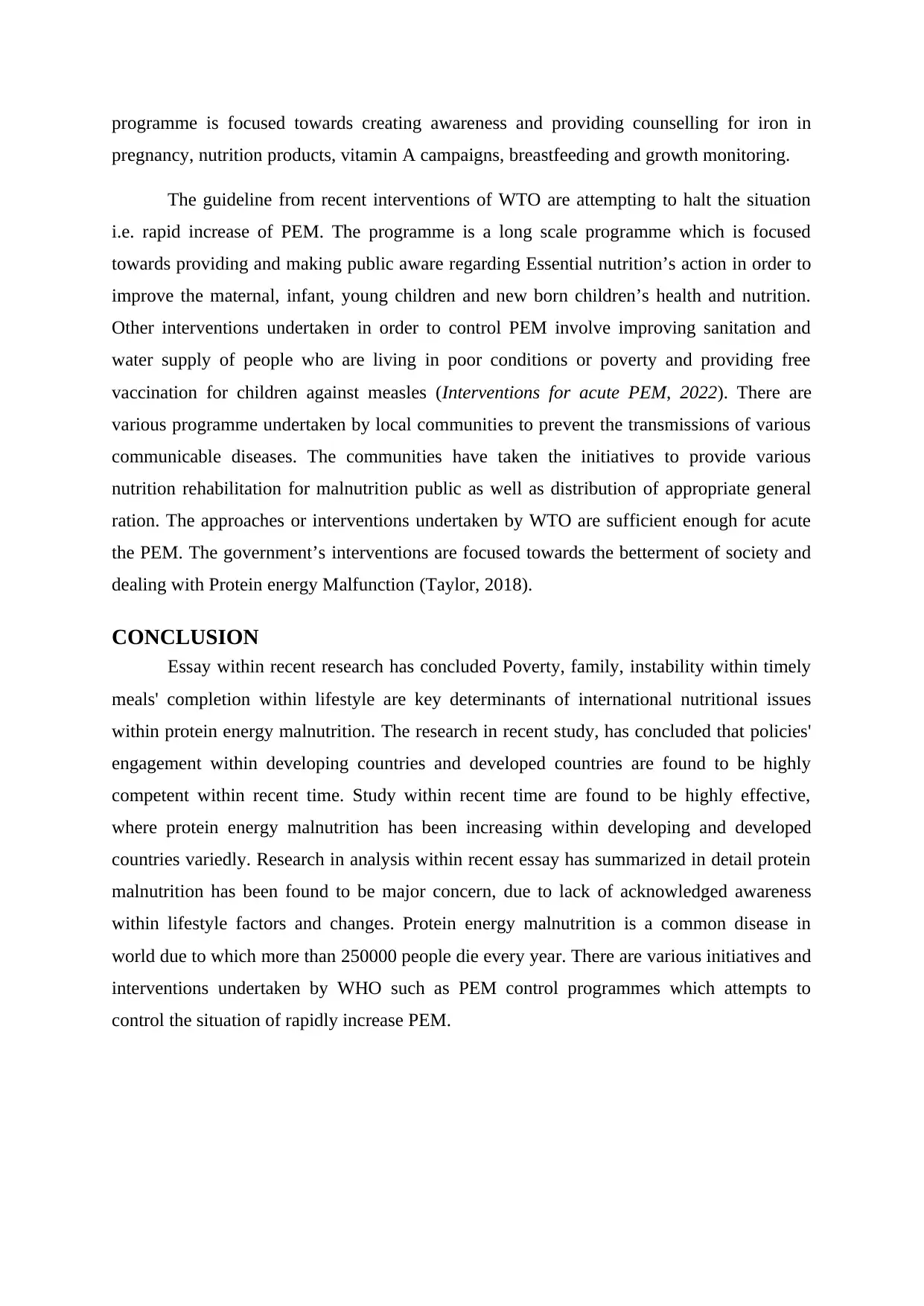
programme is focused towards creating awareness and providing counselling for iron in
pregnancy, nutrition products, vitamin A campaigns, breastfeeding and growth monitoring.
The guideline from recent interventions of WTO are attempting to halt the situation
i.e. rapid increase of PEM. The programme is a long scale programme which is focused
towards providing and making public aware regarding Essential nutrition’s action in order to
improve the maternal, infant, young children and new born children’s health and nutrition.
Other interventions undertaken in order to control PEM involve improving sanitation and
water supply of people who are living in poor conditions or poverty and providing free
vaccination for children against measles (Interventions for acute PEM, 2022). There are
various programme undertaken by local communities to prevent the transmissions of various
communicable diseases. The communities have taken the initiatives to provide various
nutrition rehabilitation for malnutrition public as well as distribution of appropriate general
ration. The approaches or interventions undertaken by WTO are sufficient enough for acute
the PEM. The government’s interventions are focused towards the betterment of society and
dealing with Protein energy Malfunction (Taylor, 2018).
CONCLUSION
Essay within recent research has concluded Poverty, family, instability within timely
meals' completion within lifestyle are key determinants of international nutritional issues
within protein energy malnutrition. The research in recent study, has concluded that policies'
engagement within developing countries and developed countries are found to be highly
competent within recent time. Study within recent time are found to be highly effective,
where protein energy malnutrition has been increasing within developing and developed
countries variedly. Research in analysis within recent essay has summarized in detail protein
malnutrition has been found to be major concern, due to lack of acknowledged awareness
within lifestyle factors and changes. Protein energy malnutrition is a common disease in
world due to which more than 250000 people die every year. There are various initiatives and
interventions undertaken by WHO such as PEM control programmes which attempts to
control the situation of rapidly increase PEM.
pregnancy, nutrition products, vitamin A campaigns, breastfeeding and growth monitoring.
The guideline from recent interventions of WTO are attempting to halt the situation
i.e. rapid increase of PEM. The programme is a long scale programme which is focused
towards providing and making public aware regarding Essential nutrition’s action in order to
improve the maternal, infant, young children and new born children’s health and nutrition.
Other interventions undertaken in order to control PEM involve improving sanitation and
water supply of people who are living in poor conditions or poverty and providing free
vaccination for children against measles (Interventions for acute PEM, 2022). There are
various programme undertaken by local communities to prevent the transmissions of various
communicable diseases. The communities have taken the initiatives to provide various
nutrition rehabilitation for malnutrition public as well as distribution of appropriate general
ration. The approaches or interventions undertaken by WTO are sufficient enough for acute
the PEM. The government’s interventions are focused towards the betterment of society and
dealing with Protein energy Malfunction (Taylor, 2018).
CONCLUSION
Essay within recent research has concluded Poverty, family, instability within timely
meals' completion within lifestyle are key determinants of international nutritional issues
within protein energy malnutrition. The research in recent study, has concluded that policies'
engagement within developing countries and developed countries are found to be highly
competent within recent time. Study within recent time are found to be highly effective,
where protein energy malnutrition has been increasing within developing and developed
countries variedly. Research in analysis within recent essay has summarized in detail protein
malnutrition has been found to be major concern, due to lack of acknowledged awareness
within lifestyle factors and changes. Protein energy malnutrition is a common disease in
world due to which more than 250000 people die every year. There are various initiatives and
interventions undertaken by WHO such as PEM control programmes which attempts to
control the situation of rapidly increase PEM.
Secure Best Marks with AI Grader
Need help grading? Try our AI Grader for instant feedback on your assignments.
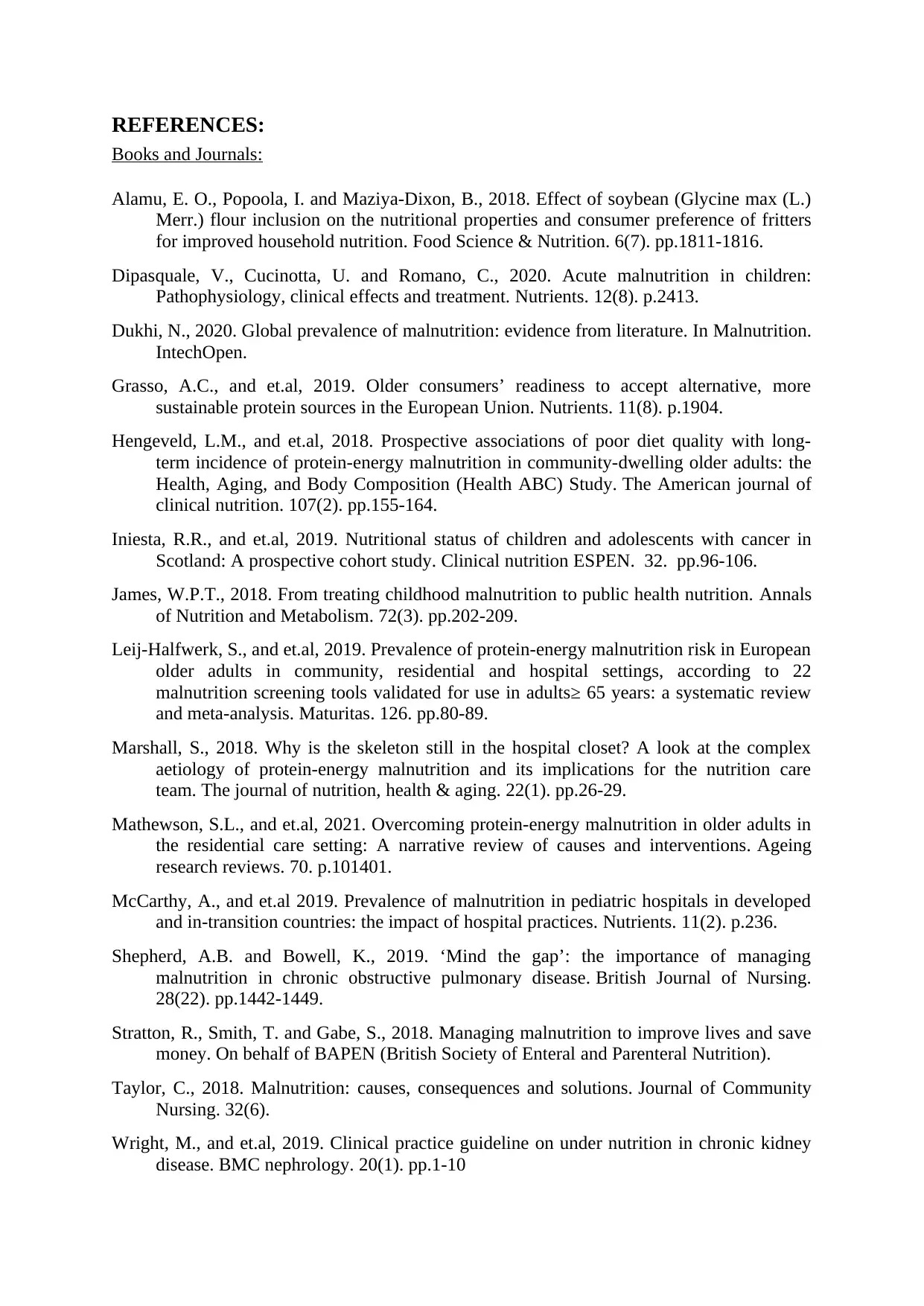
REFERENCES:
Books and Journals:
Alamu, E. O., Popoola, I. and Maziya‐Dixon, B., 2018. Effect of soybean (Glycine max (L.)
Merr.) flour inclusion on the nutritional properties and consumer preference of fritters
for improved household nutrition. Food Science & Nutrition. 6(7). pp.1811-1816.
Dipasquale, V., Cucinotta, U. and Romano, C., 2020. Acute malnutrition in children:
Pathophysiology, clinical effects and treatment. Nutrients. 12(8). p.2413.
Dukhi, N., 2020. Global prevalence of malnutrition: evidence from literature. In Malnutrition.
IntechOpen.
Grasso, A.C., and et.al, 2019. Older consumers’ readiness to accept alternative, more
sustainable protein sources in the European Union. Nutrients. 11(8). p.1904.
Hengeveld, L.M., and et.al, 2018. Prospective associations of poor diet quality with long-
term incidence of protein-energy malnutrition in community-dwelling older adults: the
Health, Aging, and Body Composition (Health ABC) Study. The American journal of
clinical nutrition. 107(2). pp.155-164.
Iniesta, R.R., and et.al, 2019. Nutritional status of children and adolescents with cancer in
Scotland: A prospective cohort study. Clinical nutrition ESPEN. 32. pp.96-106.
James, W.P.T., 2018. From treating childhood malnutrition to public health nutrition. Annals
of Nutrition and Metabolism. 72(3). pp.202-209.
Leij-Halfwerk, S., and et.al, 2019. Prevalence of protein-energy malnutrition risk in European
older adults in community, residential and hospital settings, according to 22
malnutrition screening tools validated for use in adults≥ 65 years: a systematic review
and meta-analysis. Maturitas. 126. pp.80-89.
Marshall, S., 2018. Why is the skeleton still in the hospital closet? A look at the complex
aetiology of protein-energy malnutrition and its implications for the nutrition care
team. The journal of nutrition, health & aging. 22(1). pp.26-29.
Mathewson, S.L., and et.al, 2021. Overcoming protein-energy malnutrition in older adults in
the residential care setting: A narrative review of causes and interventions. Ageing
research reviews. 70. p.101401.
McCarthy, A., and et.al 2019. Prevalence of malnutrition in pediatric hospitals in developed
and in-transition countries: the impact of hospital practices. Nutrients. 11(2). p.236.
Shepherd, A.B. and Bowell, K., 2019. ‘Mind the gap’: the importance of managing
malnutrition in chronic obstructive pulmonary disease. British Journal of Nursing.
28(22). pp.1442-1449.
Stratton, R., Smith, T. and Gabe, S., 2018. Managing malnutrition to improve lives and save
money. On behalf of BAPEN (British Society of Enteral and Parenteral Nutrition).
Taylor, C., 2018. Malnutrition: causes, consequences and solutions. Journal of Community
Nursing. 32(6).
Wright, M., and et.al, 2019. Clinical practice guideline on under nutrition in chronic kidney
disease. BMC nephrology. 20(1). pp.1-10
Books and Journals:
Alamu, E. O., Popoola, I. and Maziya‐Dixon, B., 2018. Effect of soybean (Glycine max (L.)
Merr.) flour inclusion on the nutritional properties and consumer preference of fritters
for improved household nutrition. Food Science & Nutrition. 6(7). pp.1811-1816.
Dipasquale, V., Cucinotta, U. and Romano, C., 2020. Acute malnutrition in children:
Pathophysiology, clinical effects and treatment. Nutrients. 12(8). p.2413.
Dukhi, N., 2020. Global prevalence of malnutrition: evidence from literature. In Malnutrition.
IntechOpen.
Grasso, A.C., and et.al, 2019. Older consumers’ readiness to accept alternative, more
sustainable protein sources in the European Union. Nutrients. 11(8). p.1904.
Hengeveld, L.M., and et.al, 2018. Prospective associations of poor diet quality with long-
term incidence of protein-energy malnutrition in community-dwelling older adults: the
Health, Aging, and Body Composition (Health ABC) Study. The American journal of
clinical nutrition. 107(2). pp.155-164.
Iniesta, R.R., and et.al, 2019. Nutritional status of children and adolescents with cancer in
Scotland: A prospective cohort study. Clinical nutrition ESPEN. 32. pp.96-106.
James, W.P.T., 2018. From treating childhood malnutrition to public health nutrition. Annals
of Nutrition and Metabolism. 72(3). pp.202-209.
Leij-Halfwerk, S., and et.al, 2019. Prevalence of protein-energy malnutrition risk in European
older adults in community, residential and hospital settings, according to 22
malnutrition screening tools validated for use in adults≥ 65 years: a systematic review
and meta-analysis. Maturitas. 126. pp.80-89.
Marshall, S., 2018. Why is the skeleton still in the hospital closet? A look at the complex
aetiology of protein-energy malnutrition and its implications for the nutrition care
team. The journal of nutrition, health & aging. 22(1). pp.26-29.
Mathewson, S.L., and et.al, 2021. Overcoming protein-energy malnutrition in older adults in
the residential care setting: A narrative review of causes and interventions. Ageing
research reviews. 70. p.101401.
McCarthy, A., and et.al 2019. Prevalence of malnutrition in pediatric hospitals in developed
and in-transition countries: the impact of hospital practices. Nutrients. 11(2). p.236.
Shepherd, A.B. and Bowell, K., 2019. ‘Mind the gap’: the importance of managing
malnutrition in chronic obstructive pulmonary disease. British Journal of Nursing.
28(22). pp.1442-1449.
Stratton, R., Smith, T. and Gabe, S., 2018. Managing malnutrition to improve lives and save
money. On behalf of BAPEN (British Society of Enteral and Parenteral Nutrition).
Taylor, C., 2018. Malnutrition: causes, consequences and solutions. Journal of Community
Nursing. 32(6).
Wright, M., and et.al, 2019. Clinical practice guideline on under nutrition in chronic kidney
disease. BMC nephrology. 20(1). pp.1-10

Online references:
DEATHS - PROTEIN-ENERGY MALNUTRITION - SEX: BOTH - AGE: UNDER 5 (RATE). 2022.
[Online]. Available from: < https://ourworldindata.org/grapher/protein-energy-malnutrition-
mortality-rates-in-children 2021>. [Accessed on 214 January 2022].
Interventions for acute PEM. 2022. [Online]. Available from:
<http://conflict.lshtm.ac.uk/media/WHO_Management_of_nutrition_in_major_emergencies_200
0.pdf> [Accessed on 214 January 2022].
DEATHS - PROTEIN-ENERGY MALNUTRITION - SEX: BOTH - AGE: UNDER 5 (RATE). 2022.
[Online]. Available from: < https://ourworldindata.org/grapher/protein-energy-malnutrition-
mortality-rates-in-children 2021>. [Accessed on 214 January 2022].
Interventions for acute PEM. 2022. [Online]. Available from:
<http://conflict.lshtm.ac.uk/media/WHO_Management_of_nutrition_in_major_emergencies_200
0.pdf> [Accessed on 214 January 2022].
1 out of 12
Related Documents
Your All-in-One AI-Powered Toolkit for Academic Success.
+13062052269
info@desklib.com
Available 24*7 on WhatsApp / Email
![[object Object]](/_next/static/media/star-bottom.7253800d.svg)
Unlock your academic potential
© 2024 | Zucol Services PVT LTD | All rights reserved.





